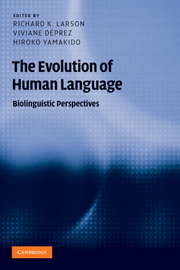Book contents
- Frontmatter
- Contents
- Figures
- Contributors
- Acknowledgments
- Introduction
- 1 The faculty of language: what is it, who has it, and how did it evolve?
- Part I Language architecture
- Part II Language and interface systems
- Part III Biological and neurological foundations
- 9 Plasticity and canalization in the evolution of linguistic communication: an evolutionary developmental approach
- 10 What is language, that it may have evolved, and what is evolution, that it may apply to language
- 11 The creative capacity of language, in what manner is it unique, and who had it?
- 12 Genetics and the evolution of language: what genetic studies reveal about the evolution of language
- Part IV Anthropological context
- Notes
- References
- Index
11 - The creative capacity of language, in what manner is it unique, and who had it?
Published online by Cambridge University Press: 05 June 2012
- Frontmatter
- Contents
- Figures
- Contributors
- Acknowledgments
- Introduction
- 1 The faculty of language: what is it, who has it, and how did it evolve?
- Part I Language architecture
- Part II Language and interface systems
- Part III Biological and neurological foundations
- 9 Plasticity and canalization in the evolution of linguistic communication: an evolutionary developmental approach
- 10 What is language, that it may have evolved, and what is evolution, that it may apply to language
- 11 The creative capacity of language, in what manner is it unique, and who had it?
- 12 Genetics and the evolution of language: what genetic studies reveal about the evolution of language
- Part IV Anthropological context
- Notes
- References
- Index
Summary
Introduction
Humans have the ability to effortlessly acquire thousands of words, which are each associated with a wide range of semantic references. Other species share this ability to a limited degree. Chimpanzees who have acquired the ability to communicate by means of manual sign language or other manual systems have 150 word productive vocabularies and can coin new words. They appear to think in terms of words, signing the names of objects as they look at picture-books (Gardner and Gardner 1980). Chimpanzees, both “common” (Gardner and Gardner 1980) and bonobos (Savage-Rumbaugh et al. 1986) can comprehend distinctions in meaning conveyed by the syntax of simple sentences and aspects of the morphology of ASL. Although present-day chimpanzees are not identical to the common ancestor of humans and apes who lived some six or seven million years ago, they in many ways are living hominoid fossils and any capacity present in chimpanzees most likely was present in our common ancestor. Likewise, any aspect of human linguistic ability that is absent in chimpanzees is a “derived” feature that evolved in the course of human evolution.
The derived properties of language that will be discussed here are speech and syntax. Chimpanzees cannot talk, although they could form many of the phonetic distinctions that convey human language (Lieberman 1968). Non-human primates lack the neural capacity that allows humans to produce a potentially limitless number of words from a finite set of motor gestures.
Information
- Type
- Chapter
- Information
- The Evolution of Human LanguageBiolinguistic Perspectives, pp. 163 - 175Publisher: Cambridge University PressPrint publication year: 2010
Accessibility standard: Unknown
Why this information is here
This section outlines the accessibility features of this content - including support for screen readers, full keyboard navigation and high-contrast display options. This may not be relevant for you.Accessibility Information
- 3
- Cited by
